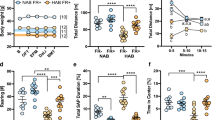Abstract
Four experiments, using 100 albino rats, were done to test the hypothesis that stimuli which are repeatedly paired with intense hunger become aversive. In Experiment I and II Ss under different degrees of hunger were put in a goal box. The aversiveness of the goal box was then assessed by the speed with which satiated Ss ran to or from the goal box (Experiment I) or to the goal box (Experiment II). In Experiments III and IV, using a within-Ss design, Ss were put in one box when hungry and another box when satiated. The aversiveness of the boxes was evluated by T-maze preference tests. No evidence was found to support the hypothesis.
Similar content being viewed by others
References
ANDERSSON, B. & LARSSON, S. 1956. An attempt to condition hypothalamic polydipsia. Acta physiol. Scand., 36, 377–382.
BROZOVICH, R., MALONY, N. & WRIGHT, L. 1963. An attempt to establish a secondary drive based upon a primary appetitional drive. Psychol. Rep., 13, 283–288.
CALVIN, J. S., BICKNELL, E. A., & SPERLING, D. 1953. Establishment of a conditioned drive based on the hunger drive. J. comp. physiol. Psychol., 46, 173–175.
D’AMATO, M. R. 1955. Transfer of secondary reinforcement across the hunger and thirst drives. J. exp. Psychol., 49, 352–356.
MILLER, N. E. 1948. Studies of fear as an acquirable drive: I. Fear as motivation and fear-reduction as reinforcement in the learning of new responses. J. exp. Psychol., 38, 89–101.
MYERS, A. K. & MILLER, N. E. 1954. Failure to find a learned drive based on hunger: Evidence for learning motivated by “exploration.” J. comp. physiol Psychol., 47, 428–436.
NOVIN, D. & MILLER, N. E. 1962. Failure to condition thirst induced by feeding dry food to hungry rats. J. comp. physiol Psychol., 55, 373–374.
PIEPER, W. A. & MARX, M. H. 1963. Conditioning of a previously neutral cue to the onset of a metabolic drive: Two instances of negative results. Psychol. Rec., 13, 191–196.
SCARBOROUGH, B. B. & GOODSON, F. E. 1957. Properties of stimuli associated with strong and weak hunger drive in the rat. J. genet. Psychol., 91, 257–261.
SCREVEN, C. G. 1959. Conditioned-hunger drive as indicated by avoidance of a situation previously associated with hunger. Psychol. Rec., 9, 109–114.
SIDMAN, M. 1960. Tactics of scientific research. New York: Basic Books.
SIEGEL, P. S. & MACDONNELL, M. F. 1954. A repetition of the Calvin-Bicknell-Sperling study of conditioned drive. J. comp. physiol. Psychol., 47, 250–252.
WRIGHT, J. H. 1965. Test for a learned drive based on hunger. J. exp. Psychol., 70, 580–584.
Author information
Authors and Affiliations
Additional information
These experiments were supported by a grant from the General Research Fund of The University of Kansas.
Rights and permissions
About this article
Cite this article
Wike, E.L., Knutson, D.L. Learned Drives based on Hunger. Psychol Rec 16, 297–303 (1966). https://doi.org/10.1007/BF03393672
Published:
Issue Date:
DOI: https://doi.org/10.1007/BF03393672




